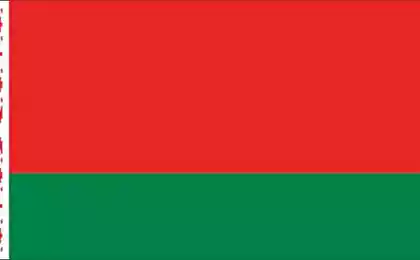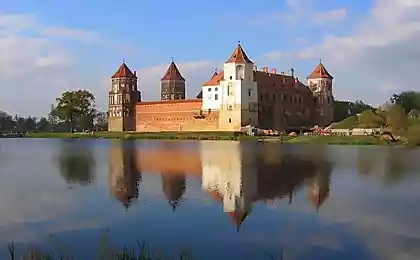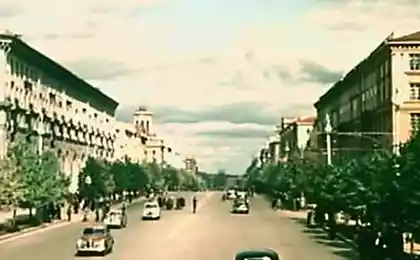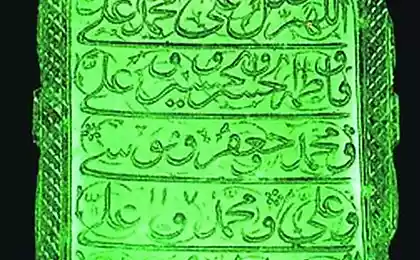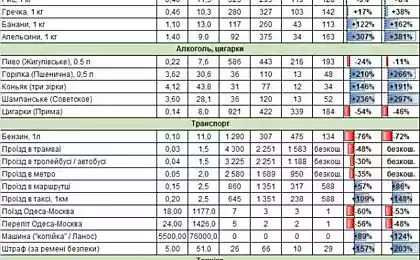1078
Minsk residents said, as he was the last great treasure found in the USSR
Belarus is one of the richest countries in Europe in the number of hidden treasures in its territory. In this interview with an expert on the history of the Belarusian capital he told how was found the last of the major treasures found in the USSR.
Now this treasure on display in one of the halls of the National History Museum of Belarus.

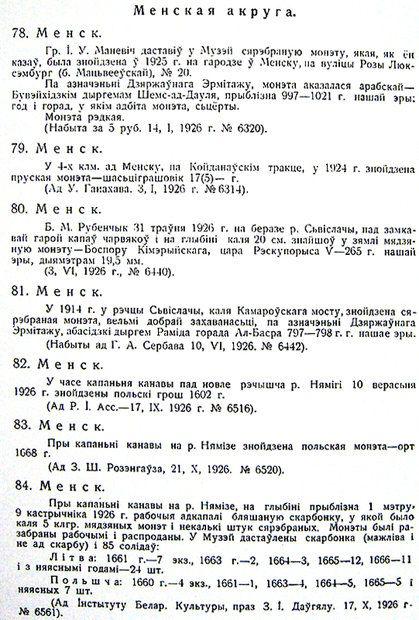
Coin hoards - the most frequent findings. But there are also monetary duffel. One of these treasures, discovered in Minsk in 1988, became a sensation both in the number and cost of objects found in it, and in their artistic and historical value. He was the last of the major treasures found in the USSR. Dubbed the "Minsk".
Here is how it was. 4 August 1988 (there was even a well established time - a quarter to twelve) on the corner of the streets of the then Volodarsky and the Republican (now - Town shaft) while digging trenches for laying of a heating bucket caught something unusual.
Blatun Leonid I.
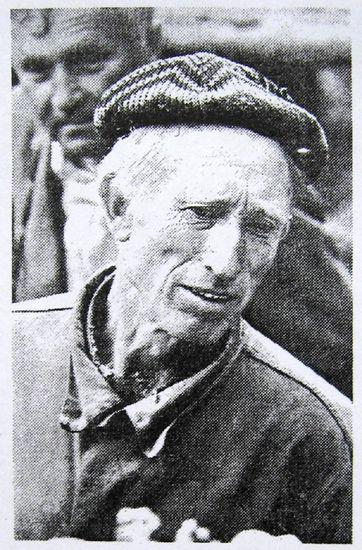
The next day the capital's newspapers carried the news of the city. "Evening Minsk" wrote: "Unusually, this was the time for the Excavator Construction Department number 4 of the trust number 1 LI Blatuna. At the time of a heating pad in the park down the street Uritskogo Leonid I. suddenly saw the sun gleaming on the subject. "
- Look, the ladle slipped glass. Rose. Silver. The gap a little ground. Box. Big box. Packed full of silver stuff - unabashedly shared the incident Leonid Blatun.
- More than thirty years of work on the excavator - continued Leonid I. - but the first time I see such a discovery. However, 25 years ago during the construction of the tram park near the street Botanical unearthed live ammunition, a meeting which was not as enjoyable as it is today.
The place where the treasure was found
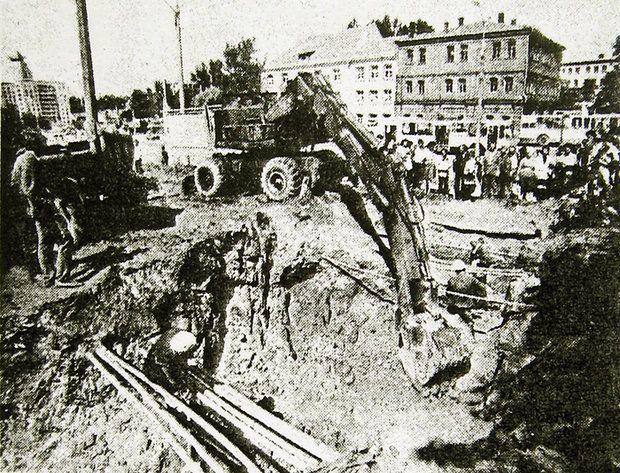
To learn how to save from looting treasure, recently told Alexander Shestopalov. "One of my colleagues told that when he was in the interval 1986-1990 years. He worked in the prison on Volodarsky, with him there was a very curious case. They walked once by police (almost all were in uniform) with dinner and passed the crossroads city wall with Volodarsky. At the corner of the intersection, near the spot where a monument to Adam Mickiewicz they still when they came to dinner, have noticed a tractor with a bucket to dig a trench for the pipe. So, they saw a crowd began to gather, and rushing to them for help tractor.
It turned out that the bucket of the tractor during the digging of the trench came across the chest, shaped more like a coffin, it hurt a little bit, and then like a fairy tale, showered with gold and silver coins, plates, cups and so on.
Tidbits - the findings could not be, because in fact there is already paved the pipe, but forgot something and had to dig another trench. In general, you know, cameras at intersections and there was no cell phone too, tractor driver to call the police, and not podospey guys in the form of time, would be carried off by onlookers coin treasure - all would not have found. But they cordoned off the perimeter, who should be called, and the treasure was saved. "
After the arrival of the police removed the rest of the excavation treasures. The treasure consisted of 547 items, among them the only silver coins and silver jewelry was thirteen kilograms.
Head of Forensic Department of the Ministry of Interior of the BSSR Alexander Komarov and investigator of the investigation department of the Ministry of Interior of the Moscow district of the Byelorussian SSR Valery Myaleshka describe the found objects.
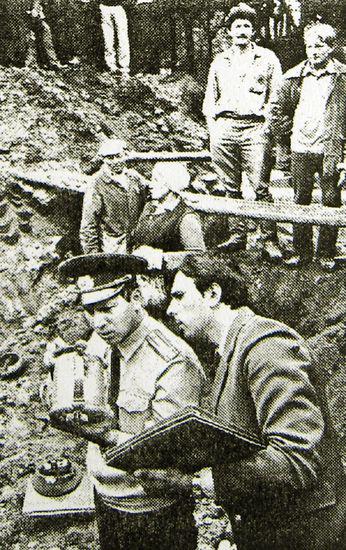
The hoard were Russian and German coins of different denominations of the late XIX - early XX century. (total - 461), including - gold pieces early twentieth century.
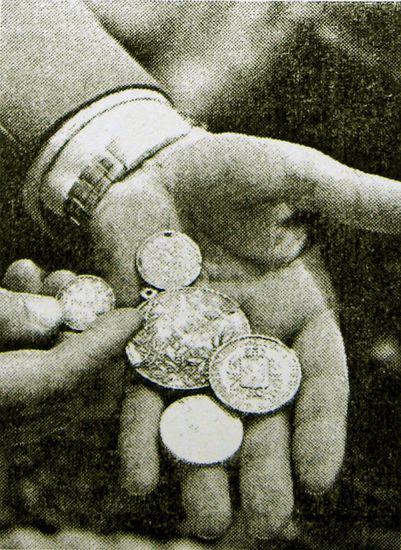
Mantu part consisted of 25 items: openwork vases, candlesticks, trays, boxes, mugs and other items of Moscow, Minsk, Riga, and Western European artists dating back to the XVII-XX centuries.

The investigator of the investigation department of the Moscow region BSSR MIA Valery Myaleshka the unusual work.
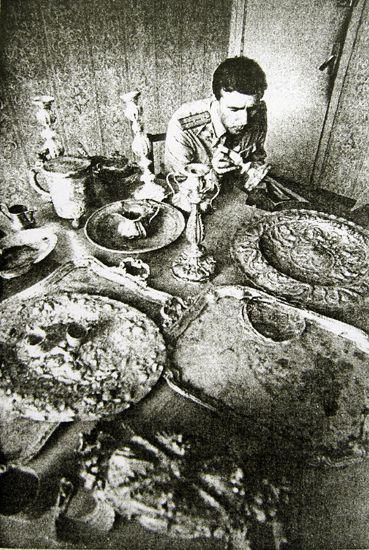
According to popular belief, not all the treasures are opened - only to the elite. These are turned excavator Leonid Welsh. This confirms the statement by the investigator V. Myaleshka:
- You know, the find had to be extracted from the earth fifteen years ago in the Ming signalers cabling. But then they did not get to her only a few centimeters ...
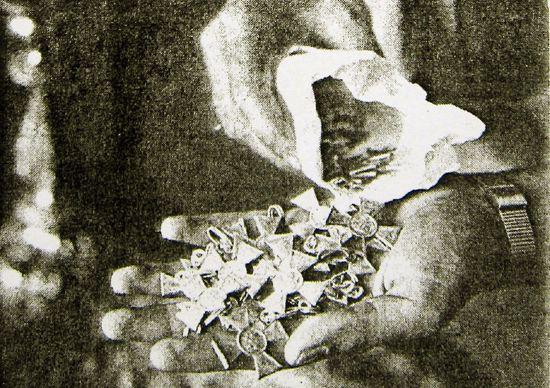
Among the items found award medals of the Russian army during the first world war: 30 George Cross, 12 Russian medals "For courage", 17 medals "For diligence".
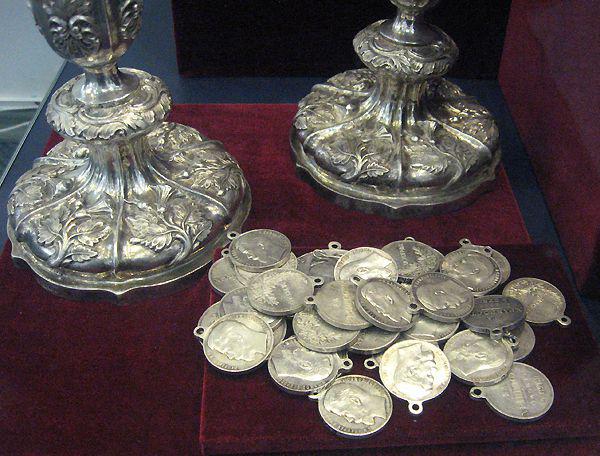
From the exposition of the National History Museum of Belarus.
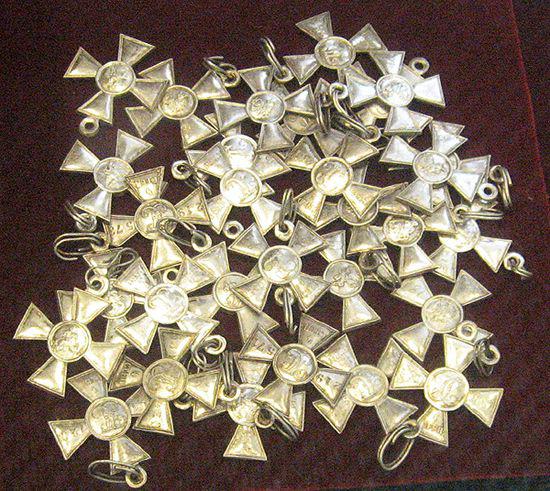
The hoard of silver objects were made masters of Moscow, St. Petersburg, Minsk, Riga. For example, sugar bowl and milk jug manufactured by "Gubkin", founded in Moscow in 1841, date back to 1855 It is with this year, the factory has received the honorary title of court supplier of silverware.

Unique casket of the XVIII century., Presented by Princess Catherine, daughter of the famous Georgian poet Alexander Chavchavadze romance.
The box is made by jewelers of Western Europe in the XVIII century.
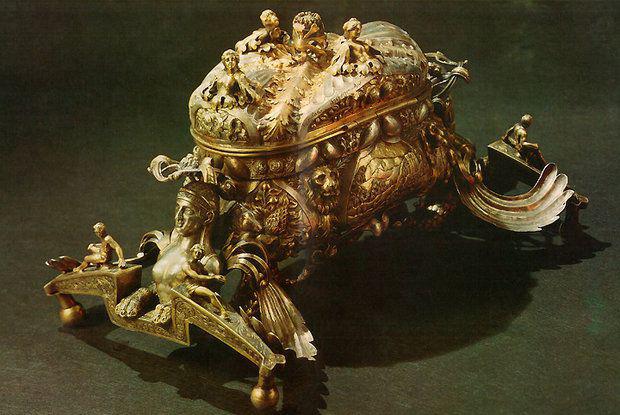
Pair candlesticks and a tray made famous jeweler Baruch Topaz Minsk in 1873. His early works belong to the 1860s and kept in the State Historical Museum in Moscow.
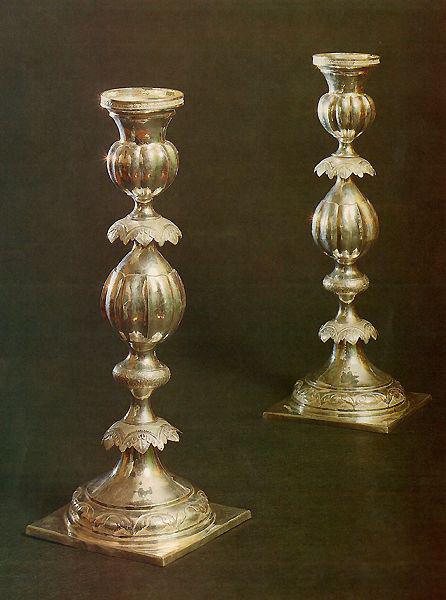
tray
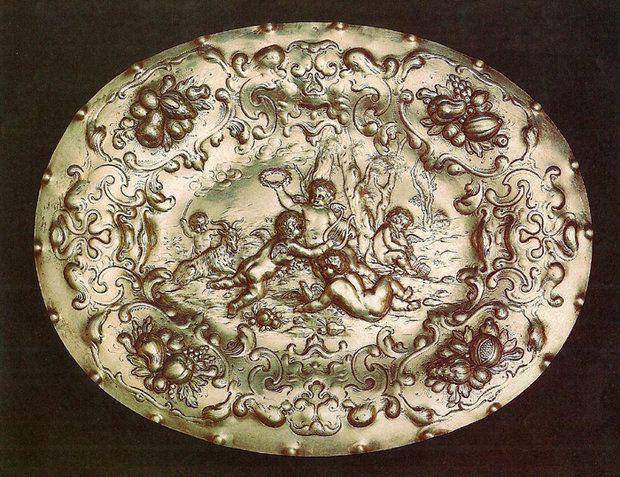
Medal "award from The Society of Vitebsk farmers»
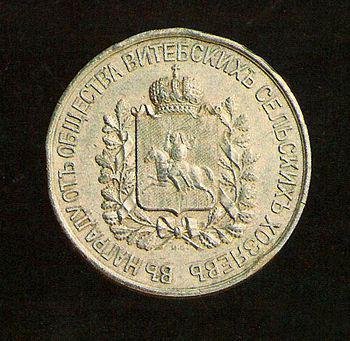
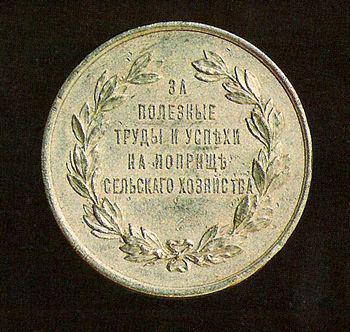
The most ancient of found objects dates from 1693 year. This Swedish circle on which is placed a medallion in honor of the Swedish king Charles X Gustav.
The inscription on the Swedish circle: «m. David Caspari pastor et inspector Rigae »
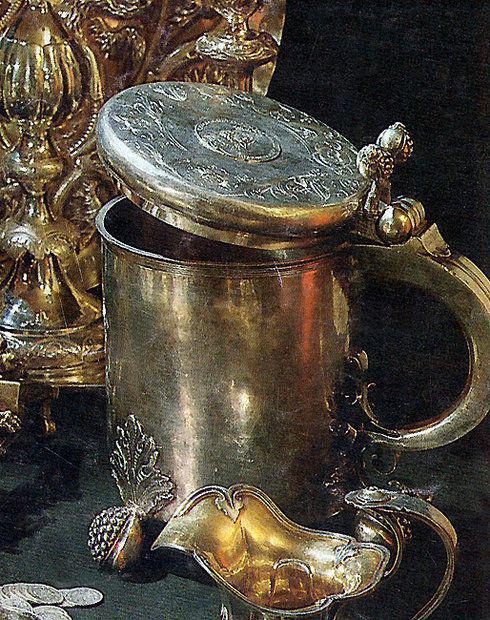
Found treasure, according to the expert committee of the Ministry of Culture of the Republic, had great historical and artistic value - no wonder it "aiming" the St. Petersburg Hermitage. Belarusians managed to defend the Ming treasure, and he was transferred to the State Museum of the Byelorussian SSR (now - the National History Museum of Belarus).
Tray, Rzeczpospolita, XVIII in.
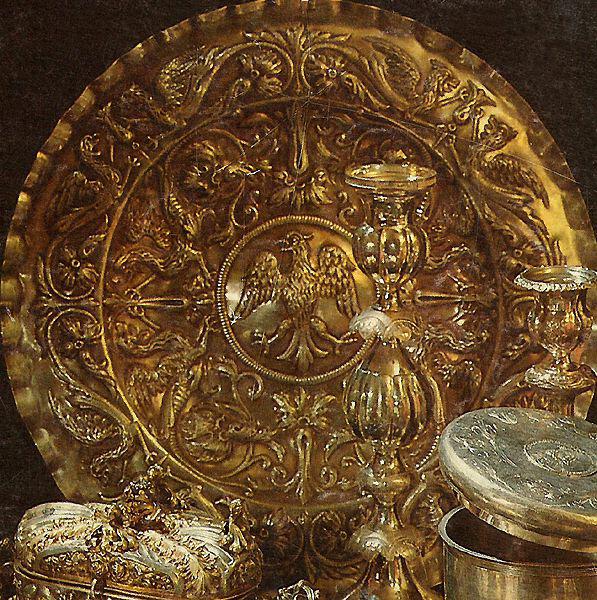
Treasure then estimated at 32,057 rubles, of which L. Blatun got put him 25% - 8014 rubles.
According to some reports Ming treasure "has been valued at hundreds of times less than its true value».
However, work was satisfied, as reported by Alexander Shestopalov:
"Two months later, the same excavator found the first of these to help police.
I do not forget, gorgeous covered meadow, and told that 25% of the position it has received.
This money was bought four-room apartment, and then still terribly deficient 24th black (!) "Volga", not to mention the belongings, gifts family and so forth. »
As later the researchers found, the treasure was buried on the territory of the former joint home ownership and some Gabriel Boyarsky Pshelyaskovskogo autumn of 1918 their structure stood on the corner of Serpukhov (Volodarsky) and Novoromanovskaya (now - Romanov Sloboda).
There was dug a trench, which found the treasure Ming
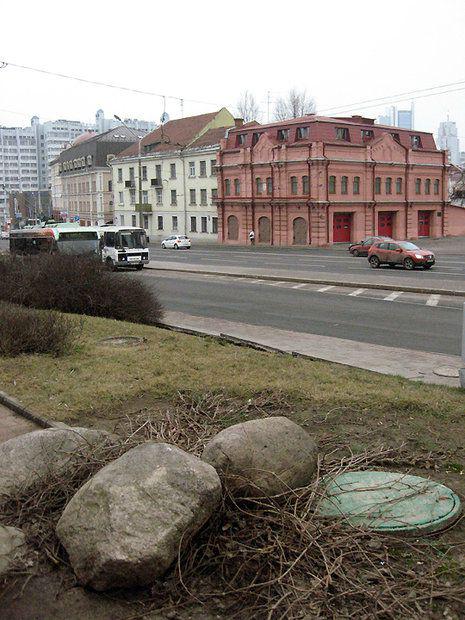
- A variety of objects Minsk monetarily-ware treasure speaks in favor of the fact that the excavator found "skhovanku" usurer of the last century - has offered its version of the archaeologist Nikolai Plavinsky.
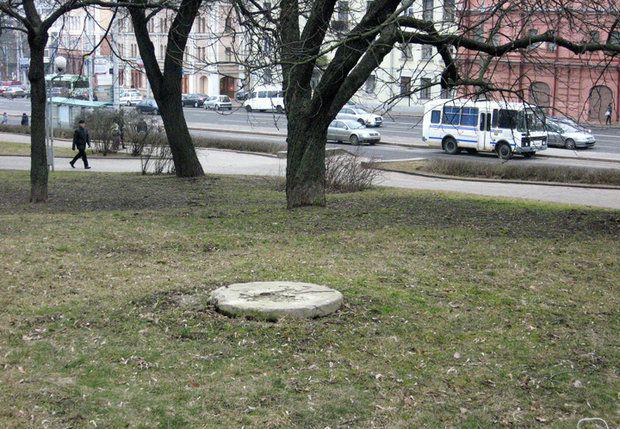
On laid underground road evidenced by the numerous hatches
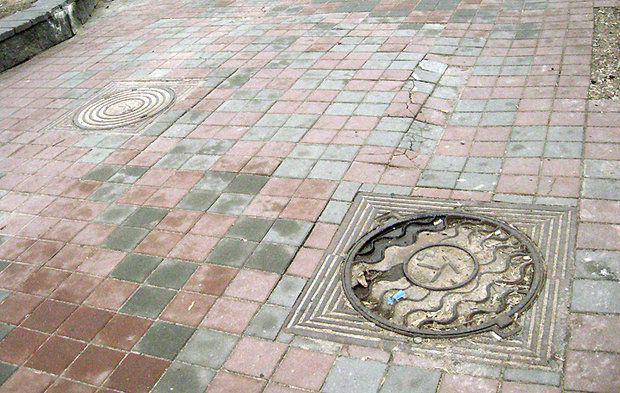
In 1990, the State Museum of the Byelorussian SSR issued an illustrated album with pictures of some of the items from the Ming treasure.
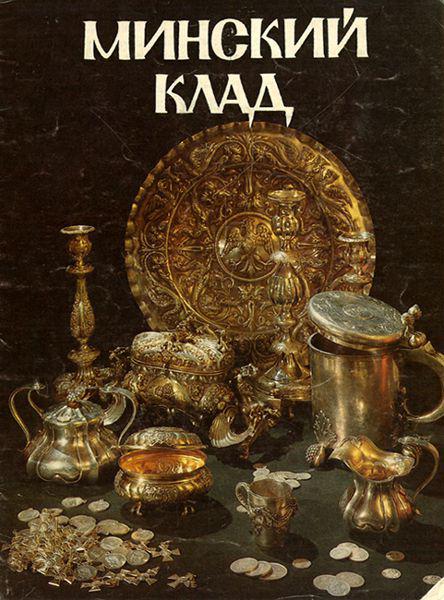
Source: news.tut.by
Now this treasure on display in one of the halls of the National History Museum of Belarus.


Coin hoards - the most frequent findings. But there are also monetary duffel. One of these treasures, discovered in Minsk in 1988, became a sensation both in the number and cost of objects found in it, and in their artistic and historical value. He was the last of the major treasures found in the USSR. Dubbed the "Minsk".
Here is how it was. 4 August 1988 (there was even a well established time - a quarter to twelve) on the corner of the streets of the then Volodarsky and the Republican (now - Town shaft) while digging trenches for laying of a heating bucket caught something unusual.
Blatun Leonid I.

The next day the capital's newspapers carried the news of the city. "Evening Minsk" wrote: "Unusually, this was the time for the Excavator Construction Department number 4 of the trust number 1 LI Blatuna. At the time of a heating pad in the park down the street Uritskogo Leonid I. suddenly saw the sun gleaming on the subject. "
- Look, the ladle slipped glass. Rose. Silver. The gap a little ground. Box. Big box. Packed full of silver stuff - unabashedly shared the incident Leonid Blatun.
- More than thirty years of work on the excavator - continued Leonid I. - but the first time I see such a discovery. However, 25 years ago during the construction of the tram park near the street Botanical unearthed live ammunition, a meeting which was not as enjoyable as it is today.
The place where the treasure was found

To learn how to save from looting treasure, recently told Alexander Shestopalov. "One of my colleagues told that when he was in the interval 1986-1990 years. He worked in the prison on Volodarsky, with him there was a very curious case. They walked once by police (almost all were in uniform) with dinner and passed the crossroads city wall with Volodarsky. At the corner of the intersection, near the spot where a monument to Adam Mickiewicz they still when they came to dinner, have noticed a tractor with a bucket to dig a trench for the pipe. So, they saw a crowd began to gather, and rushing to them for help tractor.
It turned out that the bucket of the tractor during the digging of the trench came across the chest, shaped more like a coffin, it hurt a little bit, and then like a fairy tale, showered with gold and silver coins, plates, cups and so on.
Tidbits - the findings could not be, because in fact there is already paved the pipe, but forgot something and had to dig another trench. In general, you know, cameras at intersections and there was no cell phone too, tractor driver to call the police, and not podospey guys in the form of time, would be carried off by onlookers coin treasure - all would not have found. But they cordoned off the perimeter, who should be called, and the treasure was saved. "
After the arrival of the police removed the rest of the excavation treasures. The treasure consisted of 547 items, among them the only silver coins and silver jewelry was thirteen kilograms.
Head of Forensic Department of the Ministry of Interior of the BSSR Alexander Komarov and investigator of the investigation department of the Ministry of Interior of the Moscow district of the Byelorussian SSR Valery Myaleshka describe the found objects.

The hoard were Russian and German coins of different denominations of the late XIX - early XX century. (total - 461), including - gold pieces early twentieth century.

Mantu part consisted of 25 items: openwork vases, candlesticks, trays, boxes, mugs and other items of Moscow, Minsk, Riga, and Western European artists dating back to the XVII-XX centuries.

The investigator of the investigation department of the Moscow region BSSR MIA Valery Myaleshka the unusual work.

According to popular belief, not all the treasures are opened - only to the elite. These are turned excavator Leonid Welsh. This confirms the statement by the investigator V. Myaleshka:
- You know, the find had to be extracted from the earth fifteen years ago in the Ming signalers cabling. But then they did not get to her only a few centimeters ...

Among the items found award medals of the Russian army during the first world war: 30 George Cross, 12 Russian medals "For courage", 17 medals "For diligence".

From the exposition of the National History Museum of Belarus.

The hoard of silver objects were made masters of Moscow, St. Petersburg, Minsk, Riga. For example, sugar bowl and milk jug manufactured by "Gubkin", founded in Moscow in 1841, date back to 1855 It is with this year, the factory has received the honorary title of court supplier of silverware.

Unique casket of the XVIII century., Presented by Princess Catherine, daughter of the famous Georgian poet Alexander Chavchavadze romance.
The box is made by jewelers of Western Europe in the XVIII century.

Pair candlesticks and a tray made famous jeweler Baruch Topaz Minsk in 1873. His early works belong to the 1860s and kept in the State Historical Museum in Moscow.

tray

Medal "award from The Society of Vitebsk farmers»


The most ancient of found objects dates from 1693 year. This Swedish circle on which is placed a medallion in honor of the Swedish king Charles X Gustav.
The inscription on the Swedish circle: «m. David Caspari pastor et inspector Rigae »

Found treasure, according to the expert committee of the Ministry of Culture of the Republic, had great historical and artistic value - no wonder it "aiming" the St. Petersburg Hermitage. Belarusians managed to defend the Ming treasure, and he was transferred to the State Museum of the Byelorussian SSR (now - the National History Museum of Belarus).
Tray, Rzeczpospolita, XVIII in.

Treasure then estimated at 32,057 rubles, of which L. Blatun got put him 25% - 8014 rubles.
According to some reports Ming treasure "has been valued at hundreds of times less than its true value».
However, work was satisfied, as reported by Alexander Shestopalov:
"Two months later, the same excavator found the first of these to help police.
I do not forget, gorgeous covered meadow, and told that 25% of the position it has received.
This money was bought four-room apartment, and then still terribly deficient 24th black (!) "Volga", not to mention the belongings, gifts family and so forth. »
As later the researchers found, the treasure was buried on the territory of the former joint home ownership and some Gabriel Boyarsky Pshelyaskovskogo autumn of 1918 their structure stood on the corner of Serpukhov (Volodarsky) and Novoromanovskaya (now - Romanov Sloboda).
There was dug a trench, which found the treasure Ming

- A variety of objects Minsk monetarily-ware treasure speaks in favor of the fact that the excavator found "skhovanku" usurer of the last century - has offered its version of the archaeologist Nikolai Plavinsky.

On laid underground road evidenced by the numerous hatches

In 1990, the State Museum of the Byelorussian SSR issued an illustrated album with pictures of some of the items from the Ming treasure.

Source: news.tut.by
